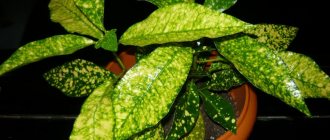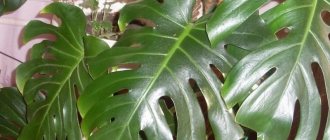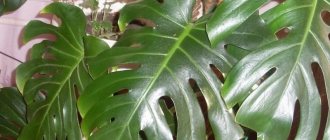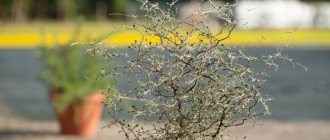Codiaēum is a beautiful plant. Its second name is croton. This is how it began to be called from the 18th century, when, due to similar characteristics, codiaum was assigned to this close genus. Now for a domestic flower, both names are synonymous and imply the same botanical species: variegated codiaum.
The genus Codium itself has only 17 species and belongs to the Euphorbiaceae family: the flower has a poisonous milky sap that can cause skin irritation, and if ingested, vomiting and diarrhea.
Codium croton is a poisonous plant. You need to work with it wearing gloves and with your hands covered. Its juice can cause skin irritation. You should also keep children and pets away from the pot with the flower.
This plant is valued for its decorative crown. It is used to decorate the interior; it looks good both at home and in the office. Its flowers are completely inconspicuous: the plant produces two arrows with male and female small flowers. Since the inflorescences are somewhat lost against the background of the leaves, and flowering takes a lot of energy, the arrows are cut off.
General information about the plant
Croton is native to the tropical forests of Eastern India, the islands of Southeast Asia and Indonesia. In nature, this plant reaches a height of 3 meters. However, variegated croton and its hybrids, which do not grow more than 1.5 meters, are grown indoors.
Croton flowers are small and inconspicuous. Therefore, the main decorative function is carried out by its bright leaves, with various patterns, depending on the variety, having different, sometimes bizarre shapes.
Watering
Codium needs to be provided with constantly moist soil and good drainage. Use warm water for watering. Any water remaining on the stand must be drained. During the summer, water 2-3 times a week. During winter dormancy, watering should be limited; the soil should not dry out completely. A pot of croton can be placed on a stand filled with expanded clay and water to increase air humidity. Fertilize every 14 days with liquid multicomponent fertilizer.
Croton varieties and names
There are only 15 species of codiaum in the wild. Thanks to the work of breeders at home, we can grow its new bright varieties.
Codiaum variety Mammi
A bright plant with unusually shaped leaves. Narrow wavy leaves, even on the same plant, can have different colors: red, green with yellow or pink splashes.
Codeium Excellent
An elegant bush whose leaves resemble oak. The leaf blades contain many colored veins of golden yellow and red. The brightness of the leaves depends on their age; the older the leaf, the more red shades it contains. Young foliage has a green-yellow hue.
Croton Mrs. Eyeston
Large-leaved codiaum with oblong-shaped leaves, pointed at the ends. Young leaves also have a green color with yellow veins, but over time they acquire pink, red, orange shades, some of them become dark green, almost black. The veins on the leaves are dark in color.
Codium Mix
In stores you can find plants called “Codiaeum Mix”. This suggests that the batch includes several varieties. The main feature is that their upper leaves have a clear edge of the same color as the leaf veins. The leaves are about 20 cm long.
Croton Sunny Star
One of the most beautiful sunny varieties of croton. The bright yellow color sometimes occupies almost the entire part of the thin tongue-shaped leaf. Numerous shoots with graceful leaves are especially decorative.
Codiaum aucubifolia
Bright yellow spots seem to be splashed on the dark green leaves of this plant. The leaf blades are narrow and have an oval-pointed shape. The variety is especially loved by flower growers.
Motley
Able to change the shape and color of foliage, depending on external factors. Due to this, it is used to obtain new varieties and hybrids that are very different in appearance.
Narrow-leaved
This group is distinguished by long, up to 30 cm and thin, about 1 cm leaves.
Splashes of champagne
The long narrow leaves of this variety are colored rich green. The brightness of the plant is added by numerous yellow spots of various diameters and shapes, which are located along the entire length of the leaf.
Zanzibar
It looks very exotic in the interior. Its long, narrow leaves have shades of green, yellow and red. All these colors collected in one Zanzibar bush make it especially bright and unusual.
Petra
The most famous and best-selling variety of croton. Large, sinewy, ovoid leaves reach 30 cm in length and form a compact decorative crown. The main feature of Petra is the very thick veins that run from the center of the leaf blade. Green and yellow colors predominate. Only older leaves take on a red tint.
Croton codium angustifolia. Variegated codiaeum (Codiaeum variegatum) Variegatum
The ancestor of all cultural species of Codiaums. In nature, it grows either as a shrub up to 1.5 meters in height, or as a four-meter tree with smooth branches and leaves located only at the ends of the branches. At home it grows up to half a meter.
It has large, up to 25-30 cm leaves, arranged alternately. The leaves are leathery and dense. Has a wide variety of colors. It grows slowly. Through selection, various species with different leaf shapes have been bred from it. In this codiaum they are initially oval in shape, the leaf blade is even.
Croton variegated
Varieties of Codiaum motley:
- Genuinum - leaves with smooth edges, flat, oval or lancet-shaped, with pointed tips at the base and tips. On the upper side of the leaf, along the central vein, golden patterns are visible. There are species with a reddish tint to the initially growing leaves;
- Decorated (picturatum) - the leaves are narrower, closer to lanceolate, the color is approximately the same as the previous variety;
- Tortoiseshell (tortile) - the leaf plate is heart-shaped at the base, then elongated with a pointed tip, twisting slightly around its axis. The color is variegated: a red central vein and a golden stripe stand out against a green background. On both sides of the sheet there are irregular spots of the same color;
- Trilobate (trilobium) - the base of the leaf is deltoid. The leaf plate itself is divided into three parts. The color of the leaves is very diverse - from stripes of different colors along the veins, to different colored spots or a combination of both;
- Wrapped (volutum) - broadly lanceolate long leaves curled towards the base. Over time, the plant takes on the shape of a ball and looks very original;
- Narrow-leaved (angustifolium) - linear narrow leaves reach a length of 25 cm with a width of 0.5 to 1 cm. Veins and random spots located on the leaves can be colored yellow.
- Appendiculatum Celak. – Distinguished by the unusual shape of the leaves. The broad oval plate at the apex narrows to a vein and then expands again, forming, as it were, a second leaf.
Features of cultivation
It takes a long time for a plant to get used to new conditions when purchased or transplanted. For croton to feel good, it is necessary to maintain a comfortable temperature and humidity for it.
In order for the codiaum to retain the pattern and brightness inherent in the variety, it is necessary to provide it with long daylight hours and bright lighting. However, it is worth remembering that the scorching rays of the sun can cause burns to the leaves. Therefore, when placing a plant on southern windows, you should think about shading so that the light is bright but diffused.
Mistake #2. Insufficient soil and air moisture
Codiaum (croton) does not tolerate even short-term drying out of the soil in the pot. In summer, it is watered abundantly, but without waterlogging the soil mixture in the planting container. In winter, watering is moderate, without drying out the surface layer of soil. In summer, the crown is sprayed daily; when the air temperature drops in winter, the leaves are wiped with a wet cloth or sponge.
Codiaum (croton) should be sprayed with soft water so that unsightly spots do not remain on the leaves.
When watering, use warm rather than cold water. The chlorinated one is defended.
Croton care at home
To make friends with a croton and tame its finicky temperament, a gardener must know how to create comfortable conditions for a pet.
The soil
Croton prefers alkaline soil with a pH of 6.5–7.4. To prepare the soil, peat, humus, and coarse sand are mixed in equal proportions and fertilized abundantly with humus.
Transfer
Plants are delivered to stores in a special transport substrate that does not allow air to pass through well. Therefore, after purchasing the croton, it is necessary to replant it.
But do not rush to replant the plant on the same day. A change of environment is a stressful situation for a sensitive codiaum; do not add additional shocks to it by changing it. Give it at least a week to adapt to the new conditions.
Croton transplant process:
- prepare a wide but shallow pot with drainage holes;
- pour a 3-centimeter layer of expanded clay or other drainage;
- pour some soil into the pot;
- carefully remove the plant from the old pot;
- carefully clean the roots from the substrate;
- place the plant in a new pot so that the roots do not come into contact with the drainage;
- add soil and water the plant.
Subsequently, transplantation is carried out in spring or summer. Young plants are transplanted annually into pots that are 3–5 cm larger than the previous ones. Adult specimens that are older than 3–4 years require replanting only after the root system fills the space of the pot.
Lighting requirements
Good lighting for croton is necessary. After all, it is thanks to light that all varieties of this plant develop their individual variegated color. With a lack of light, its leaves will be almost completely green.
In summer, codiaum needs bright but diffused light. Protect it from scorching sun rays, which can leave burns on the leaves. It is better to shade southern windows a little with light fabric.
In winter, if there is a lack of natural light, it is recommended to provide the plant with additional lighting with lamps.
Temperature
Croton grows well at temperatures from +18ºС to +25ºС. The optimal air temperature is considered to be in the range of +20–22ºС. This temperature regime must be maintained all year round.
Sudden temperature changes should not be allowed. Croton reacts sharply negatively even to watering with cold water. After which the edges of the plant's leaves turn brown.
Pinches
Croton branches well and thanks to pinching you can form a beautiful dense crown. In young plants, pinch off the top when they have reached a height of 15 cm.
Important! After pinching, it is necessary to treat the sections with a crushed tablet of activated carbon.
Watering
Water the croton with settled water at room temperature. Watering is carried out quite often, immediately after the top layer of soil dries 1-1.5 cm.
Important! Stagnation of water in a pot can lead to rotting of the roots, so the pot must have drainage and holes to drain excess liquid.
Air humidity
In a city apartment it is difficult to create the tropical forest humidity desired for a plant. But you can bring the conditions closer to its natural habitat:
- To increase humidity, you can place a humidifier or a tray of water near the crotons.
- It is advisable to wipe the leaves with a damp cloth every morning and spray plants with small leaves.
- Regularly arrange a warm shower, which cleans the foliage of dust. It is important to cover the earthen ball so as not to over-moisten the soil.
Fertilizers
The period of active growth in croton begins in May and ends in October. At this time, it is necessary to feed the plant once every 1–2 weeks. A liquid complex fertilizer, such as Oasis or Ideal, is well suited for this. Before fertilizing, you need to water the plant.
In winter, croton grows much more slowly, so fertilizing is required less often. It is enough to apply fertilizer once every 3-4 weeks.
Regular application of fertilizers not only ensures good growth of the plant, but also enhances the brightness of the color of its leaves.
Bloom
With proper care, croton blooms regularly in the summer. When flowering, the plant produces an arrow on which small fluffy balls of cream-colored flowers bloom.
Croton is an ornamental deciduous plant and its inconspicuous flowers do not give it much charm, but take a lot of energy from the plant. Therefore, experienced gardeners recommend cutting off flower stalks immediately.
Lifespan
If you provide Croton with the necessary living conditions, you can enjoy the beauty of this plant for 10 years or more. Unfortunately, not all beginners are able to “agree” with this tropical beauty and often its lifespan is no more than 1 season.
Mistake #5. Refusal to trim
Many amateur gardeners do not form croton because of its poisonous milky sap. Refusal to trim leads to loss of the tree's shape and often becomes an indirect cause of depletion of the grown plant from lack of nutrition and crowded conditions on the windowsill. The compact crown of this capricious plant is easier to care for.
Stem cuttings can be safely used to propagate the plant. First, the milky juice is washed off from them. Rooting (in a mixture of sand and peat) occurs faster with lower heating (for example, on a windowsill above a hot radiator), warmth (plus 23 - 25°C) and the use of phytohormones (you can soak the cuttings in aloe juice). This takes 1 - 1.5 months. Spring (March - April) is the best time to root cuttings, although propagation is possible throughout the year.
Croton in winter
The content of croton in winter is not much, but still differs from summer conditions. Watering is reduced a little, but they adhere to the rule that the earthen ball should always be moistened.
Wiping the leaves and spraying is carried out a little less often. But it’s better to avoid showering in winter.
Priming
For good development, codiaum needs loose, well-fertilized soil. A ready-made mixture for decorative foliage plants, which you can buy in a store, is perfect.
To make your own soil, mix in equal proportions:
- turf land;
- deciduous soil;
- peat;
- sand.
Heat the mixture in the oven for 30 minutes to kill fungi and other harmful microorganisms that may be present in the soil.
Pot
A young croton is transplanted annually into a shallow pot, slightly larger than the previous one. Mature specimens need to be replanted every 2-3 years when the roots begin to peek out of the drainage holes.
When choosing a new pot, give preference to a slightly larger one, the diameter of which is approximately 5 cm larger than the previous one.
Location
Heat-loving croton grows and develops well at temperatures of +18–25ºС. Temperatures that fall outside this range - above +26ºС and below +18ºС have a detrimental effect on the plant.
With prolonged cold temperatures below +14ºС, croton can get sick, shed all its leaves and die.
The plant does not tolerate drafts, so it is not recommended to place it near an open window or even take it out onto the balcony in summer.
Eastern or western windows are most suitable for placing croton. In the summer heat, shade the plant a little so that the scorching rays of the sun do not burn the leaves.
In winter, it is advisable to move the plant to the sunniest windowsill.
Conditions for modern varieties of codiaum
If you got a croton from among the bright modern varieties, then the possible choice of placement according to the light intensity for them is significantly limited. Such codiaum will be able to clearly display the colors on the leaves only in good, bright lighting. Varietal plants will not refuse even direct sunlight (with the exception of midday rays in summer). The more intense the lighting, the better for such plants. Varietal codiaums in shade completely lose their characteristic colors.
For codiaum, they usually change the location for the winter, placing the plants in a sunny place with intense light. In the warm season, croton is comfortable on an eastern or western windowsill, but it can spend the rest period even on the southern one. Changing placements should always be done with gradual adaptation.
The more stable the temperature range in the room in which fashionable varieties of codiaum are grown, the better. The permissible temperature range for this plant is limited to 15-25 degrees. At the same time, temperatures close to the lower level are undesirable even in winter: during the resting phase, temperatures of 16-18 degrees are preferable; hotter values will require additional care measures. In spring and summer, crotons feel good in normal indoor conditions, but increasing the readings above 25 degrees is uncomfortable for this plant.
Varietal codiaeums retain their dislike for sudden temperature changes. If the plant experiences a change in contrasting regimes, then it can completely shed its leaves. When growing codiaum, it is necessary to be extremely careful when placing the plant in relation to sources of drafts or heating devices.
Variegated codiaeum (Codiaeum variegatum)
Croton propagation
Croton propagation by cuttings
Croton is propagated by apical or stem cuttings - this is the easiest and almost always successful method. You can take cuttings and propagate croton this way throughout the year.
The most favorable time for cutting cuttings is early spring, before the plant begins to actively grow.
Reproduction process:
- select and cut a cutting 6–10 cm long, which has one internode with an adult leaf and a bud;
- Rinse off the milky juice on the cut or dry it with a napkin;
- cut the largest leaves on top of the cutting in half, they take away the strength of the shoot;
- remove the lower leaves;
- keep the cuttings dry for a couple of hours so that the cuts dry out;
- After the cuts have dried, place the shoots in warm water for rooting.
It is important that the water temperature during rooting is 25–30ºС. You can also add a growth stimulant to the water.
To ensure that cuttings take root easily, it is better to cut them from woody shoots.
When the roots reach a length of 2–3 cm, the croton can be planted in the ground.
Croton propagation by air layering
Reproduction process:
- choose a strong, woody shoot that has no foliage;
- at a distance of about 10 cm from the end of the stem, carefully cut off the bark to expose 1 cm of the trunk;
- Treat the cut area with a growth activator;
- wrap with wet sphagnum moss;
- cover with a bag and secure.
Next, moisten the moss regularly until aerial roots appear. This will happen in approximately 4–6 weeks.
After the aerial roots grow, the stem is cut off and the seedling is planted in the ground.
Croton propagation by seed
The most labor-intensive method of propagating croton. In addition, it is important to know that:
- seeds do not convey the properties of the parent plant;
- they lose their germination very quickly after ripening;
- Before sowing, be sure to disinfect the seeds.
Reproduction process:
- select the largest seeds;
- disinfect the grains by immersing them in hot water for 30 minutes;
- keep for a day in water at room temperature or a growth stimulator;
- pour loose, sterilized substrate into the pots;
- make holes in the ground, 1 cm deep;
- Place the seeds in the holes and cover them with soil;
- moisten and cover with plastic.
After the emergence of seedlings, the greenhouse is gradually opened. And when the third leaf appears, transplant the seedlings into separate pots.
Croton propagation by leaf
It is impossible to grow croton from a leaf. If you put a leaf in water, then after some time roots will appear on it, but the plant will not develop further. For successful propagation you need a leaf, at least 1 bud and part of the stem.
Pest Control
The most common pests on croton are scale insects and spider mites, which most often occur when the crown is insufficiently moistened. If moderate spraying and wiping of leaf plates are not regularly carried out, a favorable microclimate for the occurrence of bugs will arise.
- Scale insects can be identified by small growths, under which the parasite actively lays larvae, and they, in turn, suck all the juices out of the flower.
- You should look for ticks on the “wrong side” of the foliage, in a large amount of thin cobwebs.
If it was not possible to avoid the occurrence of pests, then you should first of all delicately remove them mechanically (cotton swabs are suitable as a tool). For greater effect, use a solution with laundry soap, and then treat with Actellik or any other insecticide.
Croton pests and diseases and possible problems
If croton is in unfavorable conditions for it, various diseases and pests may appear.
Pests that can settle on croton: nematode, mealybug, spider mites, scale insects.
Red spider mite
Most often, croton is affected by red spider mites. These are small, barely noticeable insects that live on the underside of leaves, entwining them with cobwebs. The cause of spider mites is usually poor watering and insufficient air humidity.
Shchitovka
Scale insects rarely attack croton. If small brown plaques appear on the leaves, then the plant is affected by scale insects and in order to save it, you need to take measures to remove it.
You can get rid of pests by wiping the leaves with a soapy solution or treating the plant with an insecticide that can be purchased at the store.
Croton dropped its leaves
If you notice that your croton has dropped its leaves, move it to a warm place. In the cold, the root system cannot function normally and moisture does not reach the shoots and leaves well.
The leaves wither and dry (the tips of the leaves dry out)
The lower old leaves dry out and fall off over time - this is a natural process. The edges of the leaves dry out from lack of watering. If dry brown spots appear on the leaves, the plant is cold, you should move it to a warmer place.
Croton sheds its leaves
Falling leaves can occur due to insufficient watering, too dry air, coolness in the room or drafts.
Also, the cause of leaf falling can be stagnation of moisture and rotting of the roots. In this case, you need to cut off the apical cutting and re-root it.
Croton growth is very slow
During winter, plant growth naturally slows down. If croton does not grow well in spring and summer, this means that it does not have enough light.
Gray or brown spots
Gray or brown spots on the leaves are a manifestation of anthracnose, a fungal disease that usually appears due to high soil moisture. To cure the plant, it is necessary to treat it with a fungicide every 10 days. Up to 4 such treatments are carried out.
Withering
The cause of leaf wilting is usually a lack of light or watering. Move the croton to a brighter place and gradually increase watering.
Important! You should not immediately overwater the plant.
How to rejuvenate croton at home?
If the plant is elongated, has a long bare stem and you are not satisfied with its appearance, you can rejuvenate the croton by cutting off the apical stalk. This technique helps to wake up the lateral buds. And the cut cuttings can be rooted.
Reasons for falling leaves and lack of flowering
As a rule, problems when growing such an exotic perennial plant as codiaum in indoor floriculture conditions arise extremely rarely. However, in case of gross violation of care technology, the following situations often arise:
- loss of decorative attractiveness of leaves caused by insufficient or excessive amounts of lighting;
- the appearance of spots on the leaves caused by burns from direct sunlight on the above-ground part of the perennial;
- browning and drying of the tips of the leaves or falling of the lower leaves is the result of increased dryness of the air and too low temperatures in the air in the room or soil;
- the appearance of numerous brown tips on the leaves indicates an insufficient amount of moisture in the nutrient substrate or in the air.
It is important to remember that low air humidity in the room where codiaum is grown often becomes the main reason for the appearance of pests or diseases on the perennial. If the air temperature in the room drops to 12°C, then a noticeable dulling of the leaf surface is observed, followed by massive leaf fall. However, it must be remembered that the coloring of young leaves is less bright than that of old foliage. This condition is normal and does not require correction.
Is the plant poisonous?
Croton is poisonous. When its juice enters the stomach, all the signs of food poisoning appear.
All work with codiaum should be carried out with gloves, and then wash your hands thoroughly with soap.
Croton is an amazingly beautiful, but capricious plant. With proper care and attention, it will decorate your home for many years with its unusual variegated foliage. To understand what a flower lacks, pay attention to its condition. You just have to be patient and you will definitely make friends with this handsome guy.
Signs associated with the plant
The plant has very powerful energy that can fight negative energy and bad thoughts. An indoor flower has a beneficial effect on the atmosphere in the house, cleanses the room of negative energy, and also brings order, comfort and regularity to the house. According to popular beliefs, croton develops eloquence, corrects poor diction, and also makes speech literate and quite clear.
With the help of codiaum, indecisive people will be able to believe in themselves and their own strengths, and will also discover new talents. This indoor flower is an ideal gift for people in the arts who often suffer from creative crises. Croton is able to add sanity and prudence to its owner, prevent rash actions, help avoid mistakes and allow you to make the right decision.
Codeum has very powerful energy that can fight negative energy and bad thoughts.
Garden varieties
In an ordinary garden, the tropical alien codiaum does not survive - the heat-loving plant does not have enough strength to survive the winter even in the southern regions of our country. However, in closed winter gardens and greenhouses it is possible to create conditions suitable for the croton plant - warmth all year round, plenty of light and high humidity.
As with home cultivation, only the variegated codiaum species is suitable for greenhouses - it is the most unpretentious and least demanding of care. The variety of its varieties will help you choose the one that you like the most and will delight the eye throughout all seasons of the year.
Description and homeland of the plant
Croton is popularly called the plant Codium variegated. The flower is a representative of the genus Codium from the Euphorbiaceae family. It is an evergreen perennial grown as a compact bush or tree. Croton leaf blades can have different shapes - ovoid, ribbon-shaped (including twisted), heart-shaped, oval, three-fingered.
A common feature of all variegated codiaums is the special color of the leaves, on “aged” specimens of which veins and spots of colors from yellow, red to brown and even black appear. All year round they look very impressive and attractive.
When grown at home, the crop rarely blooms. Since peduncles do not have decorative value, but at the same time excessively weaken the plant, they are usually removed immediately if you do not want to get seeds from it yourself. You should know that during seed propagation, varietal characteristics are not preserved.
Croton is native to a wide range that includes many Asian countries, including India and Malaysia, as well as the islands of Oceania and northern Australia. In its natural environment, the plant can take the form of a shrub or a low tree, in both cases occupying a place in the partial shade of other, taller crops.
When growing a croton flower at home, you should keep in mind that its milky sap is poisonous. You can place the plant where children and pets do not have access to it.
Meaning for home
Esotericists attribute very strong energy to croton, which can even change the atmosphere in the house.
Did you know? Codiaum is considered a vampire plant that happily feeds on the vital forces of household members, so it is better not to grow such a flower for weak, elderly and unhealthy people, especially those suffering from insomnia.
At the same time, croton will make strong and self-confident people even more successful. This flower perfectly helps you collect your thoughts, believe in your capabilities, increase self-esteem, set a goal and follow it without retreating. Codiaum also harmonizes perfectly with creative and independent people, and helps sad pessimists look at the world more positively.
The plant is credited with the strange ability to develop oratory abilities, the ability to persuade in an argument - mainly due to the ordering of thoughts and the acquisition of calm self-confidence.
Taking into account all the described properties of codiaum, you can make a list of those for whom this plant is suitable, and for whom, on the contrary, it is undesirable to have it:
| Lifestyle and character traits with which croton harmonizes | Lifestyle and character traits with which croton conflicts |
| love of order | indiscipline, chaos in thoughts and deeds |
| phlegmatic, self-confidence | prone to hysterics |
| problems with communication and selection of arguments in a dispute | increased talkativeness (will increase even more) |
| inability to force oneself to carry out plans | workaholism (requires another plant that promotes relaxation) |
| creativity, creative profession | spontaneity in decision making |
Did you know? Croton flowering is considered a bad omen. That is why, when buds appear, it is recommended to remove them immediately, but even after this, exercise extreme caution in deeds and actions, trying to understand what exactly the flower was trying to warn about.
In general, we can say that the codiaum is suitable for those people who want to change and overcome difficulties, and not obediently go with the flow. For this reason, it is very useful to install in offices.
Croton is a very beautiful decorative foliage plant that needs to create conditions that are quite difficult to provide in an ordinary city apartment. However, by finding the right balance in lighting and providing the flower with regular watering, as well as maximum air humidity, with the help of this amazing representative of the Euphorbiaceae family, you can turn your home into a real tropical garden.
The most common problems in growing
Hanging and wilted leaves are a sign of abundant watering. If they become dull or green in color, this may indicate areas that are too dark. Too dry air can cause lower leaves to drop and attack pests such as spider mites, scale insects, thrips or weevils.
Attention! The milky sap of croton can cause an allergic reaction in the form of skin irritation. Croton is poisonous to children and animals.
- Author: Maria Sukhorukikh
Rate this article:
- 5
- 4
- 3
- 2
- 1
(0 votes, average: 0 out of 5)
Share with your friends!











